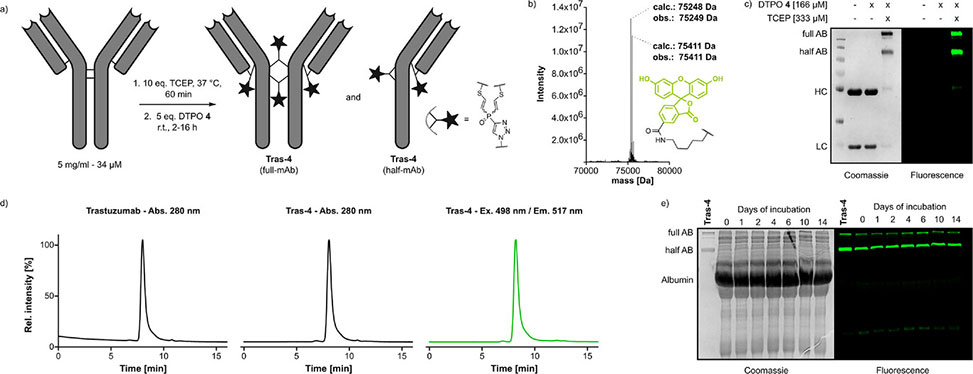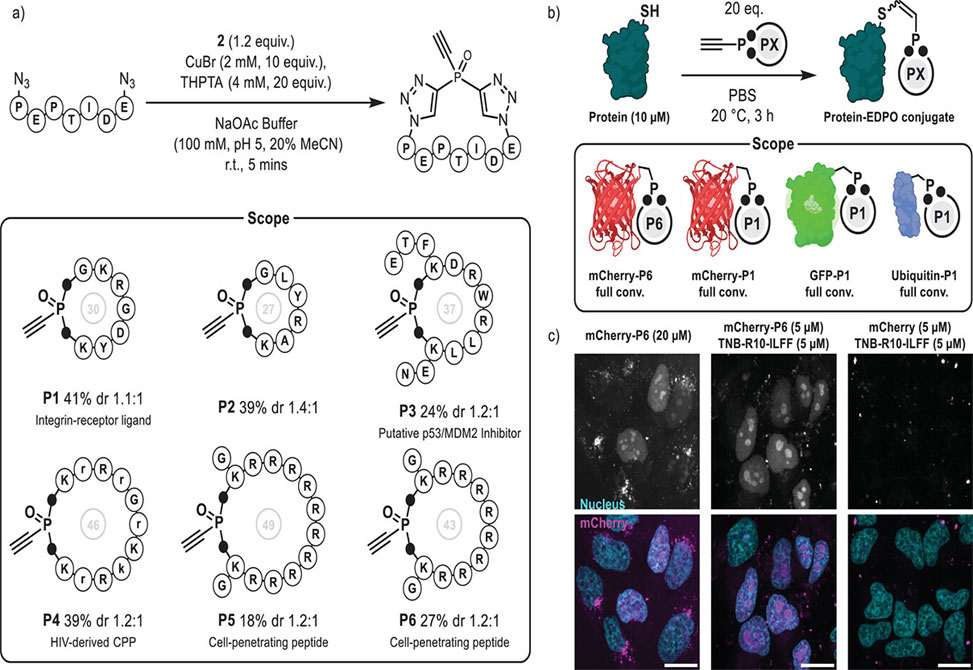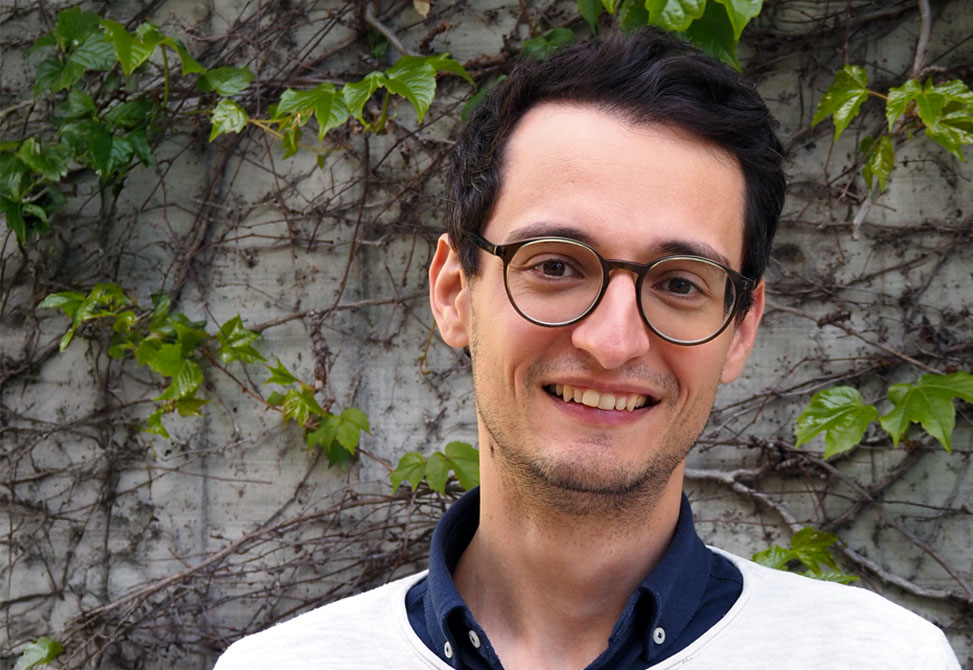Phosphine Rebridging
Reflecting work in the Hackenberger Group
Published in Angewandte Chemie International Editition, researchers from the Hackenberger Lab at the Humboldt-Universität in Berlin, present a powerful new class of phosphine oxide–based reagents for chemoselective protein modification, advancing both antibody–drug conjugate, ADC, design and peptide–protein conjugation strategies. The central innovation is the development of unsaturated phosphine oxides that can be modularly derivatized via CuI-catalyzed azide–alkyne cycloaddition, CuAAC, producing diethynyl-triazolyl-phosphine oxides, DTPOs, and ethynyl-ditriazolyl-phosphine oxides, EDPOs, with distinct reactivities and applications.

DTPOs act as highly efficient reagents for antibody disulfide rebridging, enabling homogeneous conjugates with rapid kinetics and superior stability. When applied to trastuzumab, only five equivalents of DTPO were sufficient to achieve complete rebridging within two hours, outperforming earlier diethynyl-phosphinate reagents that required overnight reactions. The resulting conjugates retained antigen selectivity and serum stability, and functionalization with tetrazine handles permitted modular payload attachment through inverse electron-demand Diels–Alder, IEDDA, chemistry. This two-step route produced a DAR ~4 trastuzumab–MMAE ADC with potent cytotoxicity against Her2-positive cells while sparing antigen-negative lines. The use of tetrazine/TCO intermediates ensures versatility across payload classes and minimizes direct handling of cytotoxic species.

a| Schematic representation of the rebridging reaction of Trastuzumab and DTPO 4. b| Deconvoluted intact protein MS spectrum of the crude reaction mixture after overnight incubation, indicating complete formation of rebridged antibody species, Tras-4. c| Reducing SDS-PAGE analysis of Trastuzumab rebridged with 5 eq. DTPO 4 overnight with or without prior reduction with TCEP. For uncropped gel see ESI 5.1.2. d| Size-exclusion chromatography analysis of Trastuzumab and Tras-4. e| Stability testing of Tras-4 incubated in human serum by SDS-PAGE. For uncropped gel see ESI 5.1.3.
Parallel to antibody modification, EDPOs emerged from double CuAAC functionalization of triethynyl-phosphine oxide. These reagents uniquely combine peptide cyclization with installation of a cysteine-reactive handle, allowing one-pot peptide macrocyclization and subsequent protein conjugation. Using azide-functionalized peptides, the authors synthesized cyclic electrophilic ligands—such as integrin-binding RGD motifs and polyarginine-based cell-penetrating peptides—that were then conjugated to proteins like mCherry. The resulting peptide–protein hybrids displayed efficient intracellular delivery, especially when combined with cell-penetrating peptide additives, underscoring the utility of this chemistry for live-cell applications.
Overall, the work establishes unsaturated phosphine oxides as versatile triple-reactive scaffolds for bioconjugation. DTPOs provide fast, selective, and stable antibody rebridging, supporting modular ADC construction, while EDPOs introduce a unique single-reagent cyclization–bioconjugation platform for peptide–protein conjugates. These advances significantly expand the chemical biology toolkit, offering modular and orthogonal approaches for precise biomolecule functionalization. By bridging metabolic logic, synthetic efficiency, and biological function, this chemistry paves the way for next-generation ADCs, stable cyclic peptides, and novel therapeutic conjugates.

a| Optimized synthetic procedure toward cyclic, electrophilic EDPO-peptides. Scope of synthesized peptides, P1-P6, numbers in the middle indicate ring-size. Azide containing amino acids are always either azido-glycine, P1, P2, or side chain azido-lysine, P1-P6. Black dots in scope represent triazole rings, see SI for full structures. b| Schematic representation of protein-bioconjugation reactions between cyclic peptides and cysteine-containing proteins. For specific conditions see SI section 3.1.16–19. c| HeLa cells treated with mCherry or mCherry-P6 in the presence or absence of TNB-R10-ILFF CPP-additive. Cells treated with mCherry-P6 in the presence of the CPP additive and at 20 µM concentration without CPP-additive showing direct translocation and nuclear localization. Scale bar = 20 µm.
Publication Information
Author Information

Dr. Christian E. Stieger obtained his Ph.D. in the group of Prof. Christian Hackenberger at the Leibniz-Forschungsinstitut für Molekulare Pharmakologie, FMP, in Berlin. During his doctoral studies, he was supported by a fellowship from the Studienstiftung des Deutschen Volkes and explored novel phosphorus(V) electrophiles for protein bioconjugation and the generation of antibody–drug conjugates. In addition to developing highly reactive yet selective reagents for cysteine modification, Christian also investigated less reactive probes as electrophilic groups for covalent inhibitors and developed bespoke probes for bacterial phosphoarginine phosphatases. For his postdoctoral research, Christian joined the group of Prof. Daniel Nomura at the University of California, Berkeley, where he is working on the design of bifunctional molecules to reprogram oncogenic transcription factors.

Dr. Alastair J. McMillan obtained his Masters and Ph.D. in the group of Prof. Daniele Leonori at the University of Manchester and RWTH Aachen where he worked on the development of new photochemical methodologies for the amination of arenes, chlorination of alkanes and sterically-controlled eliminations. For his postdoc he chose to pivot to biochemistry, working in the group of Prof. Christian Hackenberger at the Leibniz-Forschungsinstitut für Molekulare Pharmakologie where he has contributed to the group’s work on phosphorous(V) electrophiles and worked to develop photochemical methods for site-specific amino acid functionalisation.

Dr. Mark de Geus was a recent postdoctoral fellow in the group of Prof. Christian Hackenberger at the Leibniz Institute for Molecular Pharmacology, FMP. He received the Alexander von Humboldt Fellowship for Postdocs for his work, which was aimed at developing site-specific protein modification chemistry and exploring new fundamental concepts of antibody-drug conjugates, ADCs.
During his Ph.D. at Leiden University under the guidance of Prof. Sander van Kasteren and Prof. Herman Overkleeft, Mark worked on trans-cyclooctene/tetrazine ‘click to release’ bioorthogonal deprotection chemistry. He recently joined the TU Delft with a Veni grant from the Dutch Research Council, NWO. His current research aims to develop new radiation-induced deprotection chemistry with enhanced sensitivity for targeted drug release from prodrugs and ADCs.

